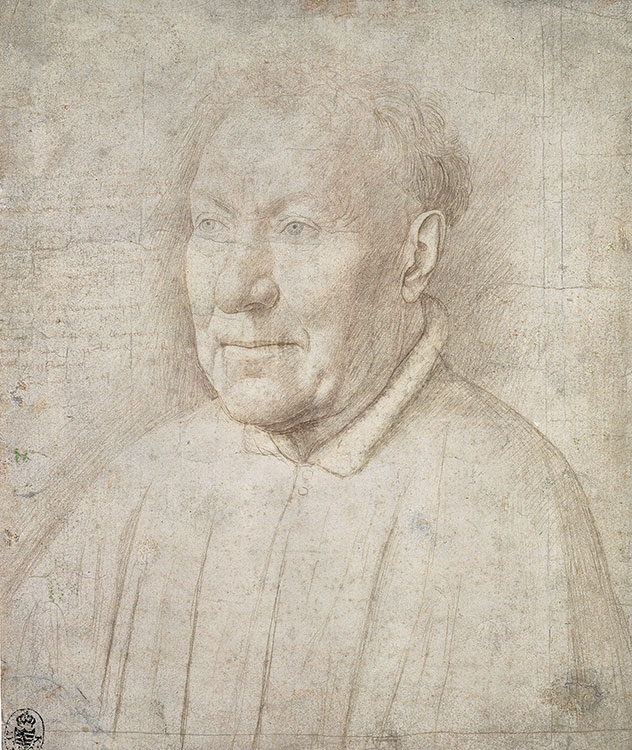
Van Eyck’s Portrait of an Older Man is a benchmark in the history of northern European draftsmanship. It is the earliest surviving study that can be securely attributed to an individual artist active in northern Europe and the only sheet universally accepted as an autograph drawing by Van Eyck. A pivotal figure in Netherlandish art, Van Eyck is renowned for his virtuosic handling of oil paint and his skill in pictorial illusionism. Made in preparation for a painted portrait (shown below), this drawing illuminates the process of careful observation behind the creation of Van Eyck’s meticulously executed panel.
The artist focused his attention on the man’s face, which he modeled using densely packed parallel lines. He was particularly concerned with the play of light, which animates the sitter’s physiognomy and imbues the likeness with a sculptural quality. While the use of silverpoint and goldpoint—traditional fifteenth-century drawing media—resulted in a monochromatic image, extensive inscriptions to the left of the man’s head vividly describe the color of his eyes, lips (“very whitish purple”), skin tone, hair, and “stubbly beard.” Van Eyck would have referred to these notes when creating the painted portrait.
Although both the drawing and painting were long believed to depict Niccolò Albergati, a Carthusian monk from Bologna, the man’s secular dress and hair argue against such an identification. More likely, the sitter is a scholar whose name is no longer known to us.
Jan van Eyck
Netherlandish, 1390–1441
Portrait of an Older Man, ca. 1435–40
Silverpoint and goldpoint on white prepared paper
Kupferstich-Kabinett, Staatliche Kunstsammlungen Dresden, INV. NO. C 775
© Kupferstich-Kabinett, Staatliche Kunstsammlungen Dresden
Photo: Herbert Boswank
Austeja Mackelaite, Annette and Oscar de la Renta Assistant Curator of Drawings and Prints
Jan van Eyck was the most famous and accomplished member of the family of fifteenth-century painters hailing from the town of Maaseick, in modern-day Belgium. Employment at the courts of Holland and Burgundy secured him a high social status, unusual for artists of the time. Van Eyck’s supreme skill in working with the medium of oil paint paved the way for a new visual aesthetic, which characterized Netherlandish painting during the fifteenth and early sixteenth centuries.
While approximately twenty paintings by Van Eyck have survived to our day, a single drawing—the Dresden sheet, in front of you—has been securely attributed to the artist. The attribution was established in the first half of the nineteenth century, on the basis of a close relationship between the drawing and a painted portrait in Vienna, also by Van Eyck, depicting the same male sitter. The Dresden sheet evidently served as a preparatory study for the Vienna work.
When I look at the drawing, I am struck by how closely Van Eyck studied his sitter, concerned with conveying the topography of the older man’s face—from the soft wrinkles around his eyes and lips, to his high cheekbones, and a square, defined chin. He was also clearly interested in the three-dimensional quality of the head, carefully transcribing the patterns of light and dark on the man’s skin, and applying intense shading outside the contours of the face. The identity of the sitter and the circumstances of the sheet’s commission remain unknown to us. Nevertheless, the somber figure—and the drawing itself—are imbued with an unmistakable power and presence.
